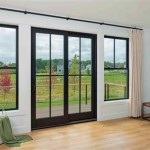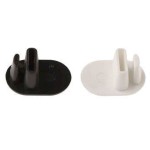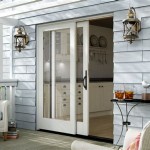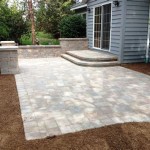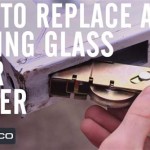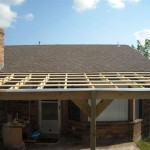Modern Patio Table: A Guide to Style, Functionality, and Selection
The modern patio table serves as a focal point for outdoor living spaces, providing a surface for dining, entertaining, and relaxation. Choosing the right table involves considering several factors, including material, size, shape, style, and durability. A well-selected patio table can enhance the aesthetic appeal and functionality of any outdoor setting.
Key Considerations Before Purchasing a Modern Patio Table
Before investing in a modern patio table, a careful assessment of the intended use and available space is essential. Factors like the number of people who will regularly use the table, the primary activities it will support, and the overall design of the patio or deck should be taken into account.
First, evaluate the size requirements. A small bistro table might suffice for a couple enjoying morning coffee, while a larger rectangular table is better suited for family dinners and social gatherings. Consider the footprint of the table and ensure it allows for comfortable seating and movement around it. Measure the available space and visualize the table in that area, leaving ample room for chairs and walkways.
Next, consider the primary use of the table. Will it be primarily used for dining, require enough space for plates, glasses, and serving dishes? If it will be used for entertaining, consider a table with an extension or removable leaf to accommodate larger groups. If the table is intended as a casual gathering spot, a smaller, round table might be a more suitable option. A coffee table height can also be considered if the area has a more casual lounge setup.
Finally, think about the overall aesthetic of the outdoor space. The patio table should complement the existing design elements, including the style of the house, the landscaping, and other outdoor furniture. Consider the color palette and material choices to create a cohesive and visually appealing outdoor environment. A modern patio table should seamlessly blend with the surrounding while serving its functional purpose.
Material Options for Modern Patio Tables
The material of a modern patio table significantly impacts its durability, aesthetic appeal, and maintenance requirements. Common material choices include wood, metal, plastic, and composite materials, each with distinct advantages and disadvantages.
Wood offers a classic and natural aesthetic, blending well with outdoor environments. Teak is a popular choice due to its inherent resistance to rot, decay, and insects. It's also incredibly durable and can withstand the elements for many years. However, teak requires regular oiling to maintain its color and prevent it from weathering to a silver-gray patina. Other wood options include cedar, redwood, and eucalyptus, each with varying degrees of weather resistance and maintenance needs. Wooden tables might require more upkeep compared to other materials, such as periodic sealing or staining, to protect them from moisture and UV damage.
Metal is a durable and versatile option, offering a range of styles from sleek and minimalist to ornate and traditional. Aluminum is a lightweight and rust-resistant choice, making it ideal for outdoor use. Powder-coated aluminum provides added protection against the elements and is available in a variety of colors. Wrought iron is a heavier and more durable option, known for its intricate designs and resistance to strong winds. However, wrought iron is susceptible to rust and requires regular maintenance, such as painting or sealing. Stainless steel is another excellent choice, offering superior corrosion resistance and a modern aesthetic. Although it can be more expensive than other metals, stainless steel requires minimal maintenance and can withstand harsh outdoor conditions.
Plastic and composite materials offer low-maintenance and cost-effective alternatives to wood and metal. Polyethylene (PE) is a durable and weather-resistant plastic that is often used in outdoor furniture. It is available in a variety of colors and styles, and it requires minimal maintenance. Recycled plastic is an environmentally friendly option, made from recycled materials such as plastic bottles and containers. Composite materials, such as wood-plastic composites (WPC), combine the aesthetic appeal of wood with the durability and low-maintenance properties of plastic. These materials are resistant to rot, decay, and insects, and they do not require painting or staining.
Glass and stone are materials often used for the tabletop of a patio table. Tempered glass is a strong and durable option that is resistant to shattering. It is easy to clean and maintain, but it can become hot in direct sunlight. Stone, such as granite or marble, offers a luxurious and elegant aesthetic. Stone tables are heavy and durable, but they can be porous and require sealing to prevent staining. Granite is particularly resistant to scratches and heat, making it a practical choice for outdoor use.
Modern Patio Table Styles and Design Trends
Modern patio tables encompass a wide range of styles, from minimalist designs that emphasize clean lines and geometric shapes to more elaborate and decorative styles that incorporate intricate details and textures. Staying abreast of current design trends can help in choosing a table that aligns with contemporary aesthetic preferences.
Minimalist design emphasizes simplicity and functionality, featuring clean lines, neutral colors, and a focus on essential elements. Minimalist patio tables often feature sleek metal frames and simple tabletop surfaces, such as glass or concrete. The emphasis is on creating a clean and uncluttered outdoor space. These tables are often paired with modern chairs with simple geometry and neutral colors.
Industrial style incorporates raw and unfinished materials, such as metal, wood, and concrete. Industrial patio tables often feature metal frames with exposed welds and distressed wood tabletops. This style embraces a utilitarian aesthetic, often incorporating visible hardware and robust construction. The incorporation of reclaimed materials adds to the industrial charm.
Mid-century modern design is characterized by clean lines, organic shapes, and a focus on natural materials. Mid-century modern patio tables often feature tapered legs, curved edges, and a combination of wood and metal elements. This style emphasizes functionality and comfort, creating a warm and inviting outdoor space. Bright colors and geometric patterns are often incorporated into cushions and accessories.
Bohemian style embraces a relaxed and eclectic aesthetic, incorporating natural materials, vibrant colors, and unique textures. Bohemian patio tables often feature woven rattan or bamboo frames and colorful mosaic tile tabletops. This style encourages mixing and matching different patterns and textures, creating a personalized and inviting outdoor space. Layered textiles, such as rugs and cushions, add to the bohemian charm.
Contemporary design blends elements of modern, minimalist, and industrial styles, creating a sophisticated and functional outdoor space. Contemporary patio tables often feature clean lines, geometric shapes, and a neutral color palette. This style emphasizes the use of high-quality materials and innovative design solutions. Integrated lighting and smart technology can enhance the functionality and aesthetic appeal of contemporary outdoor spaces.
Beyond the overall style, certain design trends influence patio table selection. For example, the use of sustainable and eco-friendly materials is becoming increasingly popular. Tables made from recycled plastic, reclaimed wood, or sustainably harvested timber are gaining traction among environmentally conscious consumers. The increasing integration of technology is also influencing patio table design, with features such as built-in charging stations and integrated lighting becoming more common.
Maintenance and Care for Modern Patio Tables
Proper maintenance and care are essential for preserving the longevity and appearance of a modern patio table. The specific maintenance requirements vary depending on the material of the table, but some general guidelines apply to all types of outdoor furniture.
Regular cleaning is essential for removing dirt, debris, and stains. Use a mild soap and water solution to clean the table surface, and avoid using harsh chemicals or abrasive cleaners that could damage the finish. For wood tables, use a soft cloth or brush to avoid scratching the surface. For metal tables, use a sponge or cloth to remove dirt and grime. For glass tabletops, use a glass cleaner to remove streaks and smudges.
Protection from the elements is crucial for preventing damage from sun, rain, and snow. Use a patio furniture cover to protect the table from the elements when it is not in use. Store the table in a shed or garage during the off-season to prevent damage from extreme weather conditions. For wood tables, apply a sealant or stain to protect the surface from moisture and UV damage. For metal tables, apply a rust inhibitor to prevent corrosion.
Specific materials require tailored maintenance. Teak wood requires regular oiling to maintain its color and prevent it from weathering to a silver-gray patina. Apply teak oil several times a year, depending on the climate and exposure to the elements. Wrought iron tables require regular painting or sealing to prevent rust. Remove any rust spots with a wire brush and apply a rust-resistant primer before painting. Plastic and composite tables require minimal maintenance, but they should be cleaned regularly to remove dirt and stains.
Addressing spills and stains promptly can prevent permanent damage. Wipe up spills immediately with a clean cloth. For stubborn stains, use a mild detergent or stain remover specifically designed for outdoor furniture. Avoid using bleach or other harsh chemicals that could damage the finish. Test any cleaning solution on a small, inconspicuous area before applying it to the entire surface.
Regularly inspect the table for loose screws, bolts, or other hardware. Tighten any loose hardware to prevent the table from becoming unstable. Replace any damaged or missing hardware to maintain the structural integrity of the table. Inspect wood tables for signs of rot or decay and address any problems promptly. Inspect metal tables for signs of rust and corrosion and address any problems promptly.
By following these maintenance and care guidelines, owners can ensure that their modern patio table remains a stylish and functional centerpiece of their outdoor living space for years to come. Proper care not only preserves the aesthetic appeal of the furniture but also extends its lifespan, making it a worthwhile investment.

Outdoor Patio Furniture At Lumens

Modern Teak Outdoor Dining Table Bond 6 Ft Rectangular

Summit Modern Outdoor Dining Table Country Casual Teak

Modern Outdoor Patio Table Ana White

7 Pc Stainless Steel Teak Modern Outdoor Rectangular Dining Table Set Regnatt Patio Furniture Garden

Mh2g Outdoor Dining Cori Modern Patio Table White

Mid Century Modern Rectangle 6 Person Extendable Outdoor Patio Dining Table Gray Black Homary

65 Great Modern Outdoor Furniture Ideas Patio Design Sofas Living Space

Dining Tables Modern Outdoor Sets And Chairs
Top 20 Outdoor Dining Table Ideas 2024 Edition 2modern
Related Posts


